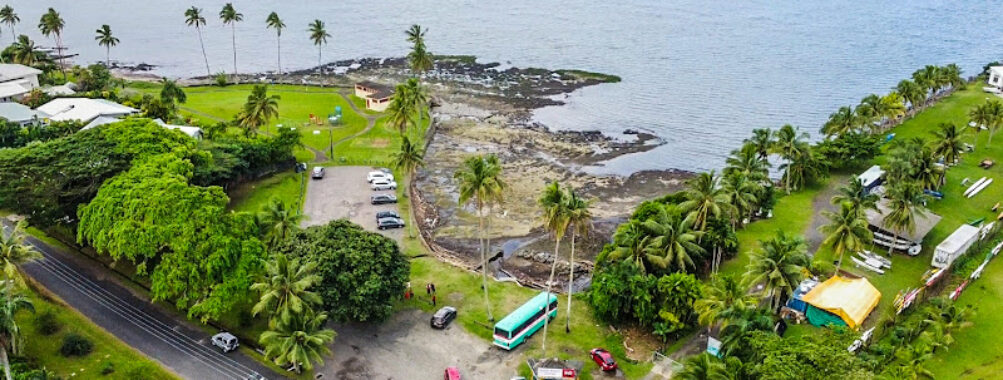
Suva Point
Table of Contents
Description
Suva Point is one of those places that quietly sneaks up on you. It’s not plastered across glossy travel mags or hyped on every influencer’s feed — and honestly, that’s part of its charm. Sitting along the coast just outside Fiji’s capital, this coastal park feels like a little pocket of calm away from the city’s buzz. You’ll find locals jogging, families picnicking, and a few travelers who somehow stumbled upon it while looking for a breather from the urban rhythm of Suva.
The shoreline here is rugged and raw — think jagged rocks, crashing waves, and the kind of salty air that sticks to your skin. It’s not a typical sandy beach spot, but it’s got this wild, untamed beauty that’s hard to forget. If you’re into fishing or photography, you’ll probably end up spending hours here without realizing it. The views stretch across the Pacific, and when the light hits just right (especially around sunset), the water glows with that deep, moody blue that only Fiji can pull off.
What I personally love about Suva Point is how it manages to balance peace and energy. You’ve got kids running around, couples sharing snacks on the rocks, and anglers patiently waiting for a bite — yet somehow it never feels crowded. It’s the sort of place where you can just sit, breathe, and watch life unfold around you. Sure, it’s not perfect — sometimes the tides bring in debris, and the weather can shift fast — but that’s part of the deal with the ocean, right? It’s real, unpredictable, and alive.
Key Features
- Scenic Coastal Views: Dramatic rocky outcrops and sweeping ocean vistas perfect for photography and quiet contemplation.
- Fishing Hotspot: Locals love casting their lines here — it’s known for decent catches and peaceful fishing conditions.
- Family-Friendly Atmosphere: Safe open spaces where kids can play and families can picnic without too much hustle.
- Local Vibe: A genuine slice of Suva life — you’ll see more locals than tourists, which makes it feel authentic and relaxed.
- Sunset Spot: The late afternoon glow over the water is simply stunning, especially if you’re into photography or just want a quiet moment.
And here’s something worth mentioning — Suva Point isn’t manicured or overly developed. Don’t expect fancy cafés or rental huts. Bring your own snacks, maybe a blanket, and just enjoy the simplicity. It’s the kind of place that rewards slowing down.
Best Time to Visit
If you ask me, the best time to visit Suva Point is late afternoon, just before sunset. The light softens, the air cools, and the whole place takes on this golden calm that’s hard to describe. But if you’re planning your trip by season, the dry months from May to October are ideal — less humidity, clearer skies, and calmer seas. The wet season (November to April) can be unpredictable, with sudden showers and rougher waves, though it does make the greenery pop like crazy.
Morning visits are great too, especially if you want a quiet stroll or some early fishing. You’ll often see locals out for their morning walks, and there’s this peaceful hush that feels almost meditative. Just bring sunscreen — that tropical sun doesn’t mess around, even early in the day.
How to Get There
Getting to Suva Point is pretty straightforward. If you’re staying in Suva city, it’s just a short drive along the coast. Most taxis or rideshares will know exactly where to go — just mention Suva Point or Apted Park, and you’ll be there in minutes. If you’re feeling adventurous, you can even walk from central Suva; it’s a pleasant stroll with plenty to see along the way, though it might get hot midday.
For those coming from outside Suva, buses and minibuses run frequently to the city, and from there, you can easily catch a local ride. Parking is usually available near the park area, though weekends can get a bit busy with families and groups hanging out. Honestly, that’s part of the fun — you get to see the community in action.
Tips for Visiting
Here’s where a few personal lessons come in handy. First — wear sturdy shoes. The rocks can be slippery, especially after rain, and flip-flops don’t always cut it. Second — bring water and snacks. There aren’t many shops right by the point, so it’s best to come prepared. Third — if you’re planning to fish, check the tides ahead of time. Locals will tell you that timing is everything out here.
And don’t rush your visit. Suva Point isn’t about ticking off a sightseeing list; it’s about soaking in the moment. Sit on the rocks, listen to the waves, maybe chat with a local fisherman — they always have the best stories. If you’re into photography, bring your gear but keep an eye on the weather. The clouds can roll in fast, but that moody atmosphere often makes for the best shots anyway.
One last thing — keep it clean. It’s heartbreaking to see trash left behind in such a naturally beautiful spot. Fiji’s coastal ecosystems are delicate, and every bit of care helps preserve them. So pack out what you bring in, and maybe even pick up a stray bottle or two while you’re at it. It’s a small act that goes a long way.
In the end, Suva Point isn’t about luxury or spectacle. It’s about connection — to the sea, to the people, and to that slower, simpler rhythm that’s so easy to forget in everyday life. It’s the kind of place you stumble upon once and then quietly keep in your memory, waiting for the day you’ll come back. And when you do, you’ll probably find it just as you left it — peaceful, raw, and wonderfully real.
Location
Places to Stay Near Suva Point
Find and Book a Tour
Explore More Travel Guides
No reviews found! Be the first to review!